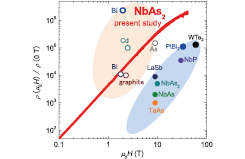Mega-Scale Magnetoresistance in the Binary Semimetal NbAs2
H. Murakawa, K. Yokoi, and T. Kida
Recently, large magnetoresistance (MR) has been reported for a wide variety of binary semimetals. The MR values for these materials reaches 103 ~ 105 below 4 K without an indication of saturation even at several tens of tesla. Although, the MR in these binary semimetals are reported to be “extremely large”, these values have been far smaller than those in classical elemental semimetals such as bismuth reported 80 years ago. In general, magnetoresistance in a semimetal is simply explained by two carrier model, in which the carrier mobility is the decisive parameter for the MR value. In fact, for ultrahigh mobility elemental semimetals such as bismuth, the MR grows rapidly in only a few tesla, resulting in the MR much larger than those recently reported for the binary systems. On the other hand, the binary semimetals tend to have lower carrier mobility. Thus, the increasing rate of MR is suppressed, resulting in a non-saturating MR with much smaller value in a reachable field. Therefore, it may be possible to enhance the MR in binary semimetals merely by improving the crystal quality.

Fig. 1. Magnetoresistance in representative semimetals exhibiting large MR. Typical area of MR in elemental (open circles) and binary semimetal (closed circles) in the previous reports are shown by different colors.
In this study, we have synthesized high quality single crystals of NbAs2 by the chemical vapor transport technique and observed an extremely large magnetoresistance exceeding 1.9 million at 1.7 K at 40 T. The present MR value is one or two orders of magnitude larger than that for the binary systems reported so far and reaches as high-level as that of the ultra-high mobility elemental semimetals. We showed that both of carrier mobility and charge compensation ratio were significantly improved in the present NbAs2 crystal exhibiting mega-scale MR. Thus, we demonstrate that the binary semimetal has a great potential to exhibit further significant enhancement of MR merely by the improvement of the crystal quality.
References
- [1] K. Yokoi, H. Murakawa, M. Komada, T. Kida, M. Hagiwara, H. Sakai, and N. Hanasaki, Physical Review Materials 2, 024203 (2018).
